- Home
- Medical news & Guidelines
- Anesthesiology
- Cardiology and CTVS
- Critical Care
- Dentistry
- Dermatology
- Diabetes and Endocrinology
- ENT
- Gastroenterology
- Medicine
- Nephrology
- Neurology
- Obstretics-Gynaecology
- Oncology
- Ophthalmology
- Orthopaedics
- Pediatrics-Neonatology
- Psychiatry
- Pulmonology
- Radiology
- Surgery
- Urology
- Laboratory Medicine
- Diet
- Nursing
- Paramedical
- Physiotherapy
- Health news
- Fact Check
- Bone Health Fact Check
- Brain Health Fact Check
- Cancer Related Fact Check
- Child Care Fact Check
- Dental and oral health fact check
- Diabetes and metabolic health fact check
- Diet and Nutrition Fact Check
- Eye and ENT Care Fact Check
- Fitness fact check
- Gut health fact check
- Heart health fact check
- Kidney health fact check
- Medical education fact check
- Men's health fact check
- Respiratory fact check
- Skin and hair care fact check
- Vaccine and Immunization fact check
- Women's health fact check
- AYUSH
- State News
- Andaman and Nicobar Islands
- Andhra Pradesh
- Arunachal Pradesh
- Assam
- Bihar
- Chandigarh
- Chattisgarh
- Dadra and Nagar Haveli
- Daman and Diu
- Delhi
- Goa
- Gujarat
- Haryana
- Himachal Pradesh
- Jammu & Kashmir
- Jharkhand
- Karnataka
- Kerala
- Ladakh
- Lakshadweep
- Madhya Pradesh
- Maharashtra
- Manipur
- Meghalaya
- Mizoram
- Nagaland
- Odisha
- Puducherry
- Punjab
- Rajasthan
- Sikkim
- Tamil Nadu
- Telangana
- Tripura
- Uttar Pradesh
- Uttrakhand
- West Bengal
- Medical Education
- Industry
Both SDF and resin-modified glass ionomer cement equally good for indirect pulp capping of deep carious lesions

Researchers have found in a new study that both silver diamine fluoride and resin-modified glass ionomer cement equally good for indirect pulp capping of deep carious lesions. SDF and SDF plus KI can be used as indirect pulp capping materials in deep cavitated lesions and they were as good as resin-modified glass ionomer cement (RMGIC) in indirect pulp capping of deep carious lesions in young permanent molars.
The study has published in the Journal of the American Dental Association.
The clinical and radiographic effectiveness of 38% silver diamine fluoride (SDF) with and without potassium iodide (KI) was tested and compared with resin-modified glass ionomer cement (RMGIC) in indirect pulp capping of deep carious lesions in young permanent molars.
One hundred eight permanent first molars with deep occlusal cavitated carious lesions in 49 children aged 6 through 9 years were randomly allocated into 3 groups (n = 36 molars per group) and treated with silver diamine fluoride (SDF) plus potassium iodide (KI), silver diamine fluoride (SDF), and resin-modified glass ionomer cement (RMGIC). Resin-modified glass ionomer cement (RMGIC) was used as a base and a resin-based composite restoration followed. Clinical assessments for secondary caries (primary outcome), postoperative pain, tooth vitality, and restoration success and quality rates according to Modified US Public Health Service and Ryge Criteria for Direct Clinical Evaluation of Restorations were performed after 3, 6, and 12 months. Periapical radiographs were obtained at baseline, 6 months, and 12 months. Outcomes were assessed using mixed effects multilevel logistic and linear regression analyses.
Results:
- There were no significant differences (P = .26) among the groups at all times for secondary caries, postoperative pain, tooth vitality, clinical abscess, radiographic signs of pulpal pathology, restorations' marginal adaption, anatomic form, and surface roughness.
- There was a significant difference (P = .03) in restoration color, marginal staining, and luster.
- The RMGIC group outperformed the 2-silver diamine fluoride (SDF) groups in color and luster.
Thus, the authors did not find differences among the groups in preventing secondary caries or pain or in maintaining pulpal health. The resin-modified glass ionomer cement (RMGIC) group had better restoration color and luster than both silver diamine fluoride (SDF) groups and better marginal staining than the silver diamine fluoride (SDF) group.
Reference:
Marwa Baraka, et al. Twelve-month randomized controlled trial of 38% silver diamine fluoride with or without potassium iodide in indirect pulp capping of young permanent molars. The Journal of the American Dental Association. Published: October 14, 2022. DOI: https://doi.org/10.1016/j.adaj.2022.08.008
Dr. Shravani Dali has completed her BDS from Pravara institute of medical sciences, loni. Following which she extensively worked in the healthcare sector for 2+ years. She has been actively involved in writing blogs in field of health and wellness. Currently she is pursuing her Masters of public health-health administration from Tata institute of social sciences. She can be contacted at editorial@medicaldialogues.in.


